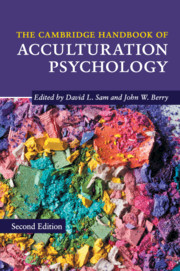Book contents
- The Cambridge Handbook of Acculturation Psychology
- The Cambridge Handbook of Acculturation Psychology
- Copyright page
- Contents
- Figures
- Tables
- Notes on the contributors
- Book part
- 1 Introduction
- Part I Theories, concepts and methods
- Part II Research with specific acculturating groups
- Part III Acculturating contexts: societies of settlement
- Part IV Applications
- Author index
- Subject index
- References
Part III - Acculturating contexts: societies of settlement
Published online by Cambridge University Press: 05 April 2016
- The Cambridge Handbook of Acculturation Psychology
- The Cambridge Handbook of Acculturation Psychology
- Copyright page
- Contents
- Figures
- Tables
- Notes on the contributors
- Book part
- 1 Introduction
- Part I Theories, concepts and methods
- Part II Research with specific acculturating groups
- Part III Acculturating contexts: societies of settlement
- Part IV Applications
- Author index
- Subject index
- References
- Type
- Chapter
- Information
- The Cambridge Handbook of Acculturation Psychology , pp. 197 - 438Publisher: Cambridge University PressPrint publication year: 2016

